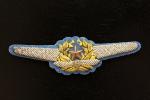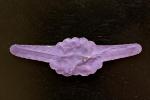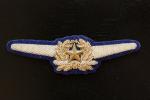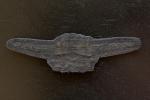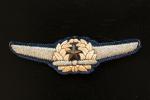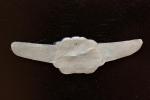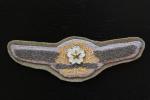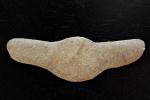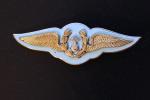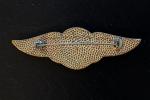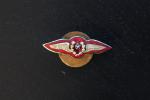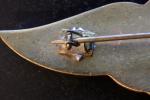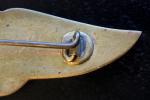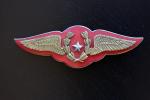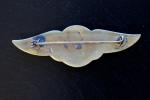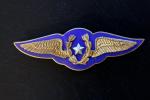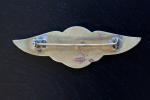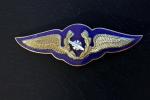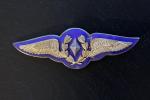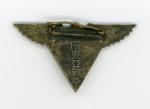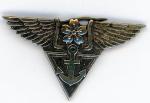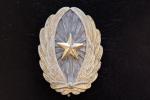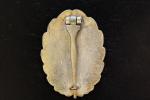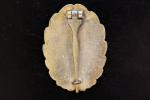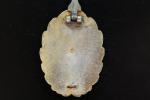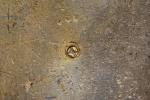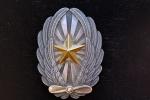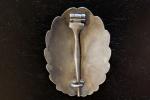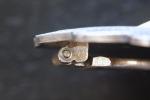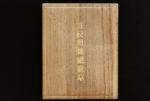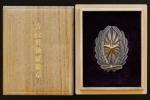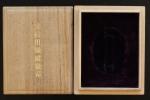-
Posts
197 -
Joined
-
Last visited
Content Type
Profiles
Forums
Blogs
Gallery
Events
Store
Everything posted by rathbonemuseum
-
The next pattern is somewhat of a hybrid. It has the heavy bullion thread and metal star of the previous type, but has the more common teal colored background. Again, this is typically referred to as an officer grade wing for use on a service dress uniform. However, I have seen this type sewn to both field and tropical uniforms and clearly worn down through use.
-
The next series is a more typical style with a lovely silver embroidered wing and gold star. This wing is typically associated with service dress for officers though I have no regulations to back that up. What makes this particular version interesting is its background color: a deep royal blue versus the more common teal blue. Note that one star is a bright fire gilt while the other is more bronze. This seems to be a matter of time and oxidation. Also note the different wing shapes. The first is a rounded tip while the second has a cut angle to the end. This seems to manufacture preference or style vs. any type of regulation. It also could be time based as the style of the wing changed. But these are the two most common types seen.
-
The first wing is unusual. I have never seen another one like it. The usual star that is in the center of the badge is replaced by a smaller star on top of a sekura, or cherry blossom, similar to the device seen on navy petty officer ranks. It seems to me this is more than simple design choice. This device signifies something particular but I am not sure what. Also of interest is the lavender color but this could be a fading of the more typical blue colored background.
-
I am going to start a thread on the pilot badges of the Imperial Japanese Army. These are typically humble embroidered badges when compared to the more elaborate metal school army flight school graduation badges and naval proficiency badges. They are also typically undervalued when compared to other WWII wings of major air powers. What I find interesting is the diversity of the wings and the lack of regulations and specificity of design in English. Perhaps more advanced collectors understand the detail of each type and are willing to share their knowledge. If you are interested in more information about metal Japanese Army pilot school graduation badges, see this thread here: http://gmic.co.uk/index.php/topic/53959-army-pilot-badge-evolution/
-
There is no order the files I will list. Let's start with Chile, the last country to declare war in 1945 against Japan. Chile still uses this style badge today but this type of manufacture with its unique pin and baked enamel is generally considered from the WWII time frame. They are as follows: 1. Red star: Pilot 2. Blue star: Pilot 3. Blue prop/engine: Engineer 4. Blue diamond: Administration
-
Since there is a such a shortage of material on this subject, I thought I would start a thread dedicated to primarily Spanish-speaking countries in the Caribbean, Central American, South American region, including Mexico for this survey. Most of these started WWII as neutrals and then came into the war late. If they were still dominated by foreign powers they came in when the corresponding country came into the conflict. For a complete list of participants, check out this wikipedia entry here: http://en.wikipedia.org/wiki/Participants_in_World_War_II
-

Unidentified Unknown IJN aviation pin badge
rathbonemuseum replied to rathbonemuseum's topic in Japan
Is that what is says in the text next to the picture? What book is that? -
-
I have don't have a fine scale. Weight will have to come later. But the silver badge (my first one) is much heavier and thicker than the aluminum alloy one (the second one). As for being an after war copy, I have not found any information about this particular badge that is definitive. Yes, I have seen crude copies where the badge is flat and the star is glued to the shield, not riveted. This alloy model seems better made and is more in appearance and construction to the better quality models. So as yet, not sure if it is either a 1) better copy or 2) poor quality original.
-
No silver mark and therefore perhaps a lower quality of silver content? But is primarily silver. And my use of "first"...only to specify that is one of two badges I was posting.
-
The second badge is much cruder and made out of some lightweight aluminum alloy. It is still made up of separate pieces but they are painted, not gilded. In addition the the gold star and propeller, the wings have also been painted gold. The star is riveted to the shield.
-
-
I finally have some good pictures of a couple of army graduation badges I will post in contribution to the thread. First is a very fine solid silver officer graduation badge in box. No inscriptions and no name.
-
Great work Nick.
-
OK. Would be great. Not often one sees the badges actually being worn. Cheers and sorry for being too busy! Happy to see the updates.
-
Thoughts about the kanji? Um, no. But as for the pictures? FANTASTIC! May I have permission to post in my museum with credit?
-

Bolivia Uniforms
rathbonemuseum replied to Cristiano Campos's topic in Rest of the World: Militaria & History
That is a great excerpt from the US publication "INSIGNIA" published around 1943. I believe many of the Central and South American countries featured are pretty out of date for what they were doing in 1943. I have been looking for those Bolivian wings for years and have only found one. The observer. Very Aztec in design. -

Estonia Estonian Air Force mechanics
rathbonemuseum replied to Noor's topic in Northern European & Baltic States
Timo, You can find it on my website: http://rathbonemuseum.com/ESTONIA/ESTMain.html I have this badge in my collection. I was wondering if you can do a high res scan focusing on just the badges so we can see a little more shape and detail? I realize the picture won't allow too much. Cheers, Tod -

Estonia Estonian Air Force mechanics
rathbonemuseum replied to Noor's topic in Northern European & Baltic States
I assume you are referring to this badge: -

Estonia Estonian Air Force mechanics
rathbonemuseum replied to Noor's topic in Northern European & Baltic States
Could be. Close with the hair. I wish you could see the badges better. I imagine you had a look with a loup. Otherwise I would have a hard time telling what they were from the pics you posted! -
Hello, I have this very nice Sergente/Sergente Maggiore tunic. It is both a service dress and with the addition of the belt, boards (spalline) and aigulettes, a full dress tunic. One problem though, it is missing something important. The ranks or "gradi". Anyone out there in the world who has a pair that would look appropriate on this nice tunic? Also looking for a hat, pants and maybe a cape? One can only hope.
-
Ed, I realize this is a post to an old thread but I would think the color belts are corps colored belts for parade. Have you found any other info or pictures?


